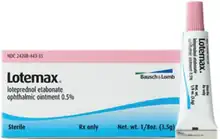Loteprednol
 | |
| Names | |
|---|---|
| Trade names | Lotemax, Loterex, others |
| Other names | Loteprednol etabonate, 11β,17α,Dihydroxy-21-oxa-21-chloromethylpregna-1,4-diene-3,20-dione 17α-ethylcarbonate |
IUPAC name
| |
| Clinical data | |
| Drug class | Corticosteroid; glucocorticoid |
| Main uses | Inflammation of after eye surgery, allergic conjunctivitis[1][2] |
| Side effects | Dry eye, eye pain, headaches[1] |
| WHO AWaRe | UnlinkedWikibase error: ⧼unlinkedwikibase-error-statements-entity-not-set⧽ |
| Pregnancy category |
|
| Routes of use | Eye drop |
| Onset of action | ≤2 hrs (allergic conjunctivitis) |
| External links | |
| AHFS/Drugs.com | Monograph |
| Legal | |
| Legal status |
|
| Pharmacokinetics | |
| Bioavailability | None |
| Protein binding | 95% |
| Metabolism | Ester hydrolysis |
| Metabolites | Δ1-cortienic acid and its etabonate |
| Elimination half-life | 2.8 hrs |
| Chemical and physical data | |
| Formula | C24H31ClO7 |
| Molar mass | 466.96 g·mol−1 |
| 3D model (JSmol) | |
| Melting point | 220.5 to 223.5 °C (428.9 to 434.3 °F) |
| Solubility in water | 0.0005 mg/mL (20 °C) |
SMILES
| |
InChI
| |
Loteprednol, sold under the brand name Lotemax among others, is a corticosteroid used to treat inflammation after eye surgery and allergic conjunctivitis.[1][2] It is used as an eye drop.[1] It should not be used for more than 2 weeks.[1]
Common side effects include dry eye, eye pain, and headaches.[1] Other side effects may include change in taste and facial swelling.[1] It should not be used in people with herpes simplex keratitis.[2]
Loteprednol was patented in 1980 and approved for medical use in 1998.[3] In the United Kingdom 5 ml cost the NHS about £6.[1] In the United States this amount costs about 200 USD.[4] It also comes as a combination medication with tobramycin.[2]
Medical uses
Applications for this drug include the reduction of inflammation after eye surgery,[5] seasonal allergic conjunctivitis, uveitis,[6] as well as chronic forms of keratitis (e.g. adenoviral and Thygeson's keratitis), vernal keratoconjunctivitis, pingueculitis, and episcleritis.
Contraindications
As corticosteroids are immunosuppressive, loteprednol is contraindicated in patients with viral, fungal or mycobacterial infections of the eye.[5][6][7]
Side effects
The most common side effects in patients being treated with the gel formulation are anterior chamber inflammation (5%), eye pain (2%), and foreign body sensation (2%).[8]
Interactions
Because long term use (>10 days) can cause increased intraocular pressure, loteprednol may interfere with the treatment of glaucoma. Following ocular administration, the drug is very slowly absorbed into the blood, therefore the blood level is limited to an extremely small concentration, and interactions with drugs taken by mouth or through any route other than topical ophthalmic are very unlikely.[5]
Pharmacology
Mechanism of action
Pharmacokinetics
Neither loteprednol etabonate nor its inactive metabolites Δ1-cortienic acid and Δ1-cortienic acid etabonate are detectable in the bloodstream, even after oral administration. A study with patients receiving loteprednol eye drops over 42 days showed no adrenal suppression, which would be a sign of the drug reaching the bloodstream to a clinically relevant extent.[5]
Steroid receptor affinity was 4.3 times that of dexamethasone in animal studies.[5]
Retrometabolic drug design
Loteprednol etabonate was developed using retrometabolic drug design. It is a so-called soft drug, meaning its structure was designed so that it is predictably metabolised to inactive substances. These metabolites, Δ1-cortienic acid and its etabonate, are derivatives of cortienic acid, itself an inactive metabolite of hydrocortisone.[5][7][9]
 Cortisol, a naturally occurring corticosteroid, known as Hydrocortisone when used as a drug
Cortisol, a naturally occurring corticosteroid, known as Hydrocortisone when used as a drug Δ1-Cortienic acid, inactive metabolite of loteprednol
Δ1-Cortienic acid, inactive metabolite of loteprednol Cortienic acid, inactive metabolite of hydrocortisone
Cortienic acid, inactive metabolite of hydrocortisone
Chemistry
Loteprednol etabonate is an ester of loteprednol with etabonate (ethyl carbonate). The pure chemical compound has a melting point between 220.5 °C (428.9 °F) and 223.5 °C (434.3 °F). Its solubility in water is 1:2,000,000,[7] therefore it is formulated for ophthalmic use as either an ointment, a gel, or a suspension.[10]
Loteprednol is a corticosteroid. The ketone side chain of classical corticosteroids such as hydrocortisone is replaced by a cleavable ester, which accounts for the rapid inactivation.[11] (This is not the same as the etabonate ester.)

Synthesis
Society and culture

Cost
The medication has a cost in the U.S. of $189 (USD) for 5 ml, ophthalmic suspension 0.5% [13]
.svg.png.webp) Loteprednol etabonate costs (US)
Loteprednol etabonate costs (US).svg.png.webp) Loteprednol etabonate prescriptions (US)
Loteprednol etabonate prescriptions (US)
References
- 1 2 3 4 5 6 7 8 BNF 81: March-September 2021. BMJ Group and the Pharmaceutical Press. 2021. p. 1223. ISBN 978-0857114105.
- 1 2 3 4 "Loteprednol Monograph for Professionals". Drugs.com. Archived from the original on 29 August 2021. Retrieved 24 November 2021.
- ↑ Fischer J, Ganellin CR (2006). Analogue-based Drug Discovery. John Wiley & Sons. p. 488. ISBN 9783527607495. Archived from the original on 2021-03-21. Retrieved 2020-09-20.
- ↑ "Loteprednol ophthalmic Prices, Coupons & Patient Assistance Programs". Drugs.com. Archived from the original on 28 August 2019. Retrieved 24 November 2021.
- 1 2 3 4 5 6 Haberfeld H, ed. (2015). Austria-Codex (in German). Vienna: Österreichischer Apothekerverlag.
{{cite book}}: CS1 maint: unrecognized language (link) - 1 2 Loteprednol Professional Drug Facts.
- 1 2 3 Dinnendahl V, Fricke U (2008). Arzneistoff-Profile (in German). Vol. 6 (22 ed.). Eschborn, Germany: Govi Pharmazeutischer Verlag. ISBN 978-3-7741-9846-3.
{{cite book}}: CS1 maint: unrecognized language (link) - ↑ "Highlights of Prescribing Information: Lotemax" (PDF). 2012. Archived (PDF) from the original on 2017-02-25. Retrieved 2018-10-04.
- ↑ Bodor N, Buchwald P (2002). "Design and development of a soft corticosteroid, loteprednol etabonate". In Schleimer RP, O'Byrne PM, Szefler SJ, Brattsand R (eds.). Inhaled Steroids in Asthma. Optimizing Effects in the Airways. Lung Biology in Health and Disease. Vol. 163. Marcel Dekker, New York. pp. 541–564.
- ↑ "Loteprednol (Professional Patient Advice)". Archived from the original on October 4, 2018. Retrieved October 4, 2018.
- ↑ Pavesio CE, Decory HH (April 2008). "Treatment of ocular inflammatory conditions with loteprednol etabonate". The British Journal of Ophthalmology. 92 (4): 455–9. doi:10.1136/bjo.2007.132621. PMID 18245274. S2CID 25873047.
- ↑ Druzgala P, Hochhaus G, Bodor N (February 1991). "Soft drugs--10. Blanching activity and receptor binding affinity of a new type of glucocorticoid: loteprednol etabonate". The Journal of Steroid Biochemistry and Molecular Biology. 38 (2): 149–54. doi:10.1016/0960-0760(91)90120-T. PMID 2004037. S2CID 27107845.
- ↑ "Loteprednol ophthalmic Prices, Coupons & Patient Assistance Programs". Drugs.com. Archived from the original on 28 August 2019. Retrieved 4 April 2021.
Further reading
- Stewart R, Horwitz B, Howes J, Novack GD, Hart K (November 1998). "Double-masked, placebo-controlled evaluation of loteprednol etabonate 0.5% for postoperative inflammation. Loteprednol Etabonate Post-operative Inflammation Study Group 1". Journal of Cataract and Refractive Surgery. 24 (11): 1480–9. doi:10.1016/s0886-3350(98)80170-3. PMID 9818338. S2CID 24423725.
External links
| Identifiers: |
|---|
